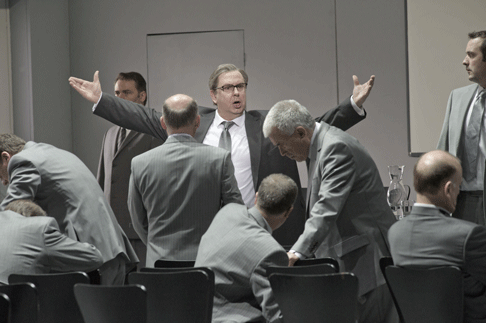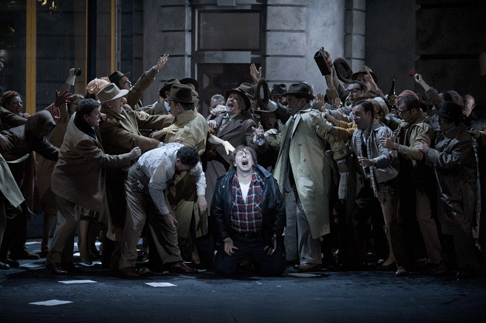Not only
did the set for the prologue, a town square in 1960s mafia-controlled Genoa,
follow Miller’s Rigoletto in drawing on Edward Hopper’s
‘Nighthawks’, but it was also an urban variation of the desert
diner design of Miller’s 2009 L’elisir d’amore.
As trench-coated gangster, trilbies inclined to mask their plotting and
intriguing, gathered in a night-time cafÈ, and Graham-Greene-esque figures
lurked menacingly on street corners, a stylish car rolled in from stage right,
and then proceeded to flash its lights unceasingly — and
headache-inducingly — for the entire prologue.
Certainly the designs for this prologue were by far the most engaging, and
dramatically relevant, of the evening. When we whizzed on twenty-five years
(or, in this production, perhaps forty years) for Act 1, minimalism took over
from realism — although the assault on the audience’s eyes
continued, this time in the form of a glaring white square on the bleak, black
back wall. The Grimaldi household was a sparse and modernist affair: one white
arm-chair, one wall painting. In fact, the latter had occasioned the most
surprising and exciting moment of the production, when the final tableau of the
Genoan street scene was electronically transferred to a stage drop and
electronically shrunk, rapidly receding only to reappear as a pictorial memory
of the past on the wall of the family home.
In the final two acts, a featureless, grey, rather underequipped committee
room, in a bland corporate command centre, replaced the majestic Doge’s
place of the original scenario. The fully functioning wall clock suggested a
countdown to crisis, but why did the various stages of action commence at
seeming random hours thereby destroying the realism? There were many other non
sequiturs: doors which were immovably fixed, but then swung freely open; a text
(translation by James Fenton) which spoke of ‘swords’ as the
gangsters brandished their steel hand guns. Motifs and ideas were introduced
but not developed: so, having decided to update the action almost to the modern
day, Tcherniakov seemed to lost interest in pursuing real-life parallels after
the prologue — a pity, as there is plenty of potential for highlighting
modern-day coups d’Ètat , given recent history and even the
contemporary ‘Arab Spring’. Moreover, the costumes did little to
add to the impression that this was a serious attempt to portray political
power struggles: Adorno’s biker’s leathers and Amelia’s
grungy Doc-Martens jarred with the endless grey suits, and I’d be
grateful for an explanation as to why Boccanegra sported a ludicrous paper hat
on his head during his final decline?
I’m not sure that Tcherniakov was really interesting in engaging his
audience. He frequently placed his characters to the rear or edges of the
stage, or with their backs to the auditorium; and, it was unclear at times
whether characters sharing the stage could or couldn’t see/hear each
other. Add some inexplicable stage business — the desperate wrestling
over Maria’s dead body which was almost ripped apart in a tug-of-war
between Boccanegra and the patriacians; Paolo’s cartoonish writhing and
squirming when, alone on stage at the end of Act 1 Scene 1, he bitterly
conjures up his dastardly plot; the final tussle between Amelia and her new
husband, Adorno, with the plebs joining in the fisticuffs as the curtain fell
— and the overall vision was incomprehensible.

Perhaps Tcherniakov thought that because the plot is so notoriously
complicated that such details would not matter. Indeed, he tried to help us
follow the action by projecting the unfolding readout of a tele-printer onto
the stage drop before each act or scene. These were indeed useful at times,
but, presumably to cover a tricky scene stage, an overly explanation after the
prologue caused the action to stagnate, diminishing the musico-dramatic
momentum which has been so skilfully built by conductor, Edward Gardner. And,
there are inherent dangers in highlighting the libretto’s more ridiculous
moments: an inevitable audience chuckle accompanied the bald statements, in
successful sentences, that Amelia had been abducted, but … she had now
managed to escape. There are many awkward ‘fudges’ in the text, and
they are probably best ignored — the music should make the narrative and
emotional drama clear.
Thank goodness, then, that the music and much of the singing were top notch.
As the eponymous champion of the people, Bruno Caproni — after an
underwhelming start during which an over-indulgent vibrato muddled the
intonation — grew in stature, and in his final poignant portrayal of
regret revealed an expressive, flexible voice of pleasing tone. His diction was
superb throughout, even when he was placed in the margins or at the rear of the
stage. Roland Wood, as Paolo, also took some time to get into his stride, but
produced a strong performance in the final Act. Peter Auty and Rena Harms were
musically effective but not entirely suited dramatically to their roles as
Adorno and Ameila. Both exhibited brightness and lightness at the top of their
registers, but lacked some of the gravity required; Harms struggled to convey
the developing complexities of Amelia’s character as her knowledge and
understanding of her past and present increase, while Auty had tuning some
problems during his big moments.

Best of the bunch was Brindley Sharratt’s Fiesco; although Fiesco was
clutching an asthmatic’s inhaler, he clearly suffered no problems with
his lungs, and produced a powerful tone which carried the clearly articulated
to the farthest reaches of the house. Despite his vengeful plotting, with its
tragic consequences, Sharratt won the audience’s sympathy, and the final
duet between Fiesco and the faltering Boccanegra was immensely moving.
But the loudest applause of the night was deservedly awarded to Edward
Gardner and the ENO orchestra. Gardner gradually ratcheted up the musical and
dramatic tension, controlling the broader structures with a masterful sweep.
The way he whipped the chorus from pianissimos to fiery climaxes was
astounding. Sensitive to the needs of the drama, and individual singers, he
also allowed the instrumentalists free rein when it was the turn of the score
to carry the responsibility for the expressive drama. It was a relief that at
least someone was able to make a coherent unity of the work.
Claire Seymour
image=http://www.operatoday.com/Simon-Boccanegra_Brindley-S.gif
image_description=Brindley Sherratt as Jacopo Fiesco [Photo by Mike Hoban courtesy of English National Opera]
product=yes
product_title=Giuseppe Verdi: Simon Boccanegra
product_by=Simon Boccanegra: Bruno Caproni; Amelia Boccanegra: Rena Harms; Jacopo Fiesco: Brindley Sherratt; Gabriele Adorno: Peter Auty; Paolo Albiani: Roland Wood; Pietro: Mark Richardson; A captain: David Newman; Amelia’s maid: Judith Douglas. Conductor: Edward Gardner. Director: Dmitri Tcherniakov. Set Designer: Dmitri Tcherniakov. Lighting Designer: Gleb Filshtinsky. Video Designer: Finn Ross. English National Opera, London Coliseum. Wednesday 8th June, 2011.
product_id=Above: Brindley Sherratt as Jacopo Fiesco
All photos by Mike Hoban courtesy of English National Opera